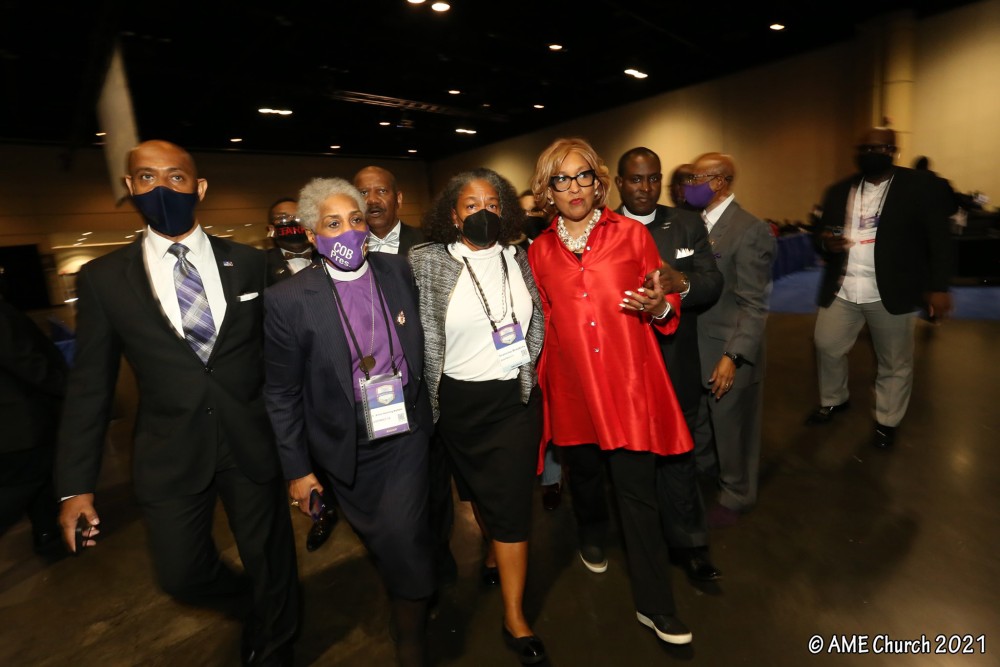Women making strides in Black denominations amid hesitancy

Women in Black Baptist circles knew that it was only a matter of time before one of their own was named to lead a major church organization.
Female clergy describe having a sense of anticipation for years before the elevation of Gina Stewart this summer to president of the Lott Carey Baptist Foreign Mission Society, a 124-year-old movement of about 10,000 volunteers and contributors based in Maryland.
“We knew Gina Stewart was going to become the president in 2021,” said Leslie Callahan, pastor of St. Paul’s Baptist Church in Philadelphia. Callahan said “there was excitement and energy” as Stewart rose in the ranks of the society.
Read our latest issue or browse back issues.
But questions remain about where Black denominations stand on women’s leadership.
While the African Methodist Episcopal Church consecrated its first female bishop more than two decades ago, the AME Zion Church, which dates to 1796, was recently criticized for not maintaining women in top leadership roles when its general conference met this summer.
AME Zion members have a sole female bishop, Mildred “Bonnie” Hines, in addition to a woman at the head of an all-female organization. The Progressive National Baptist Convention has never had a woman in its top post, though its male leaders hailed the importance of women at more than one session of their recent meeting.
The Pew Research Center, in its February report on faith among Black Americans, found that significant majorities of Black women (87 percent) and men (84 percent) believe women should be permitted to serve in congregations as senior religious leaders. But the National Congregations Study reported that only 16 percent of Black Protestant churches in 2018–19 were led by women.
“We don’t have any problem with ladies in leadership in our church,” said AME Zion senior bishop Kenneth Monroe. “None.”
He pointed to Julia Foote, who was ordained in the denomination in the late 1890s.
“It’s just unfortunate that we didn’t elect anybody this time. But I’m sure, in times to come, we will elect another lady as a bishop and as an officer in the church,” he said, noting his personal efforts to appoint women and men to leadership positions, including as regional presiding elders.
“I have been very, very intentional about trying to place men and women in leadership, because we need both to lead our church.”
At a Social Justice Commission forum this summer, the PNBC also talked about its intentions to elevate women’s voices and talents.
But two days before the event, during a PNBC conversation among current and past presidents, former leader Ralph W. Canty Sr. implied that the time for intentions alone had passed.
“We have embraced women in ministry, but 60 years later we have not yet elected a woman president of this convention. Sixty years later we have not elected a woman vice president of this convention—why not?” he asked. “It’s time now for us to take the next step and move forward.”
Callahan said others in the PNBC have raised these questions, but talk of a “theoretical woman” has not yet led to an actual female leader.
Some members of the AME Church, which elected Vashti McKenzie its first female bishop in 2000, were angry when the denomination came close to electing no women among its four new bishops at its meeting this summer. With McKenzie’s retirement the total number of women bishops remains at two.
Erika Crawford, international president of AME Women in Ministry, said she was “incensed” when candidates who had pulled out of the race supported other male candidates instead of women who had received significant votes in earlier balloting. Four of the original 22 candidates were women.
Crawford explained what it can take to elect a female bishop in today’s church world. With two slots left and two men already elected, she said, “we began to rally and to use our influence, and to call on our allies to ensure that a woman, a qualified woman, was seated on the bench,” the Delaware pastor said.
For about ten tense minutes the women’s advocates texted other delegates who were watching online from different rooms in the Florida convention center and as far away as Africa.
Crawford said she was elated when Francine A. Brookins, the first biracial AME bishop and the daughter of a bishop, was elected.
“I think it was a wonderful thing, because it made a statement that the church is still moving forward, that we’re not going to regress for a handful of people,” she said. “We will remain progressive in our quest for parity and representation in the church.” —Religion News Service






